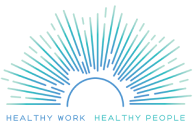Principles of Healthy Work
The Principles of Healthy Work are one of several tools created by the Healthy Work Campaign (HWC) to learn about, discuss and promote “healthy work.” The Principles are intended to educate working people and all stakeholders (employers, labor leaders, regulators, journalists, educators, and others) with a common understanding of what healthy work is and how it is related to health, well-being and the chronic disease burden.
The Principles are a very brief summary of some of the most essential and recognized elements of (un)healthy work, based on a large, international body of scientific research. The following five categories describe the main factors that need to be considered in promoting “healthy work.” This is just one way to organize what we know about healthy work, so it’s easier to understand, relevant and accurate.
The following five categories describe the main factors that need to be considered in promoting “healthy work.”
- physical environment
- psychosocial environment
- organizational culture/climate
- work organization
- rewards/benefits

Principles of Healthy Work
Click categories to learn more.
A healthy work environment should be free of physical hazards. These include safety and mechanical hazards, toxic chemicals, noise, radiation, infectious diseases, extremes of heat and cold, ergonomic design hazards (e.g., heavy lifting, prolonged standing and computer work without adjustable equipment).
All organizations have a “culture” that reflects the values and practices of its leaders and supervisors. A workplace’s “climate” reflects how managers and workers relate to each other, the organization’s policies and practices, and how respectfully and fairly workers are treated. A positive work climate can reduce work stressors and improve your health and well-being.31
How management organizes tasks and work in general (work organization) includes many things. It can cover: employment arrangements (e.g., full/part-time, employee, contractor/temp worker); staffing decisions or practices (e.g., lean production); downsizing and restructuring practices; work hours, shifts, and schedules (e.g. on-call, irregular schedule, forced overtime). Psychosocial work stressors are a consequence of how work is organized5 and are linked to poor mental and physical health, and chronic disease, higher healthcare costs and loss of productivity.6
Rewards are the economic and other benefits (e.g., promotions, seniority status, job security, support, and respect) that are the expected outcome of work. When rewards do not match the required effort or responsibility of a job, this is a major stressor (i.e., “effort-reward imbalance”). Fair pay and living wages, access to paid time off to use preventive care, or when you’re sick or to take care of family, and adequate health insurance and retirement benefits—all are necessary, along with reducing work stressors, for the overall health of working people and to lower the risk of illness, disease and early death.7
A healthy work environment should be free of physical hazards. These include safety and mechanical hazards, toxic chemicals, noise, radiation, infectious diseases, extremes of heat and cold, ergonomic design hazards (e.g., heavy lifting, prolonged standing and computer work without adjustable equipment).
All organizations have a “culture” that reflects the values and practices of its leaders and supervisors. A workplace’s “climate” reflects how managers and workers relate to each other, the organization’s policies and practices, and how respectfully and fairly workers are treated. A positive work climate can reduce work stressors and improve your health and well-being.31
How management organizes tasks and work in general (work organization) includes many things. It can cover: employment arrangements (e.g., full/part-time, employee, contractor/temp worker); staffing decisions or practices (e.g., lean production); downsizing and restructuring practices; work hours, shifts, and schedules (e.g. on-call, irregular schedule, forced overtime). Psychosocial work stressors are a consequence of how work is organized5 and are linked to poor mental and physical health, and chronic disease, higher healthcare costs and loss of productivity.6
Rewards are the economic and other benefits (e.g., promotions, seniority status, job security, support, and respect) that are the expected outcome of work. When rewards do not match the required effort or responsibility of a job, this is a major stressor (i.e., “effort-reward imbalance”). Fair pay and living wages, access to paid time off to use preventive care, or when you’re sick or to take care of family, and adequate health insurance and retirement benefits—all are necessary, along with reducing work stressors, for the overall health of working people and to lower the risk of illness, disease and early death.7
Note: All reference numbers in the above tool direct you to the Research Articles section on our Research page.
You may download and print a summary of the Principles of Healthy Work.
Were they helpful? Any questions or comments? Please contact us. We’d love to hear from you.






